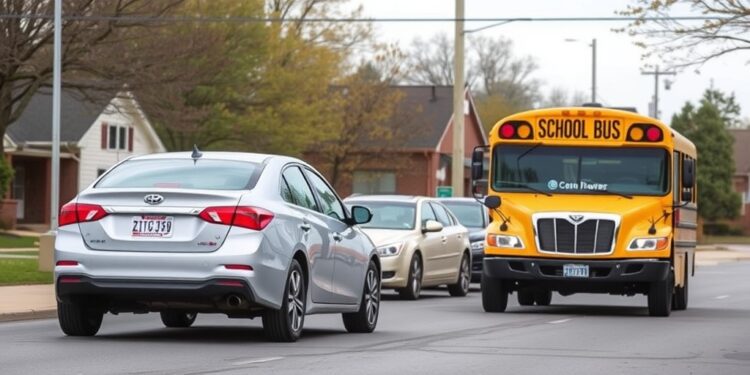Recent research highlights alarming trends in school zone safety, particularly concerning hazardous driving behaviors observed during morning drop-off periods. With increasing reliance on private vehicles, the risk of accidents involving child pedestrians has escalated, shedding light on urgent issues that require immediate attention. The study published in the esteemed journal, "Traffic Injury Prevention," provides a detailed analysis of unsafe driving practices prevalent near elementary schools across Canada, drawing from data collected over a significant two-year period.
The findings reveal that a staggering 98% of elementary schools experience unsafe driving behaviors during morning drop-off times, including double parking and disobeying traffic signals. These practices not only compromise the safety of children but also contribute to a chaotic environment during one of the busiest times of the school day. The most concerning behavior identified was the act of dropping children off across the street, forcing them to cross without adequate traffic control, often in the middle of the block. This raises serious questions about parental awareness and the current urban planning practices surrounding school zones, urging a need for immediate reforms.
The implications of the study extend beyond the immediate risks faced by children on their way to school. Research indicates that such driving behaviors can increase the likelihood of accidents involving minors and vulnerable road users, such as cyclists, by a staggering 45%. Furthermore, parents’ inclination to drive their children instead of opting for active modes of transportation, like walking or biking, reflects broader issues related to urban infrastructure and accessibility. This trend not only undermines child health and development but also fosters an environment where hazardous driving practices thrive.
To address the critical issues identified in the study, researchers advocate for various interventions, including the implementation of ‘kiss-and-ride’ programs that designate safe drop-off zones for parents. These initiatives could significantly alleviate traffic congestion while promoting safer practices among drivers. The study also emphasizes the need for accessible parking solutions for families with disabled children, underscoring the importance of inclusivity in planning school zones.
Interestingly, the study observed patterns linked to the speed limits around schools, suggesting that areas with lower speed limits saw fewer risky driving behaviors. The researchers noted that schools with more stringent parking restrictions and better-designed road access exhibited a significantly lower frequency of unsafe driving practices. This correlation underscores the critical role of urban design and environment in enhancing road safety for children during school drop-off times.
Tona Pitt, a Research Associate involved in the study, stressed the urgent need for solutions to mitigate the dangerous driving habits observed in school zones. The chaotic nature of drop-off times has become a familiar concern voiced by parents, residents, and educators alike. By quantifying the extent of risky behaviors, this research provides a compelling narrative for why immediate changes are necessary to ensure the safety of children traveling to and from school.
As the research points out, improvements to the built environment surrounding schools can play a vital role in creating safer spaces for children. This includes potential modifications to road designs, better signage, and the presence of designated crossing guards, all of which could help promote safer behaviors among parents and drivers alike. Ultimately, these efforts should focus on encouraging active transportation, which offers numerous benefits to children’s physical health and overall development.
The Child Active Transportation Safety and the Environment (CHASE) study, which served as the foundation for this research, encompassed an extensive review of the physical environment adjacent to 552 elementary schools across several cities in Canada. This comprehensive analysis included audits of speed limit signage, designated parking zones, and the presence of crossing guards, emphasizing the intersection between urban design and child safety.
Although the research did not account for the precise frequency of risky behaviors, it did establish that at least one unsafe driving practice was observed at every school included in the study. The findings reveal an unsettling trend, suggesting that comprehensive strategies must be adopted to significantly reduce these unsafe driving practices and ultimately safeguard the well-being of children during school commuting times. The overall picture painted by the data is concerning, warranting a thorough examination of current transportation policies and urban planning initiatives related to school zones.
The research carried out across various cities indicated that some unsafe behaviors, such as U-turns, were particularly prevalent in urban areas like Toronto. The study calls for a deeper understanding of how regional characteristics influence traffic patterns and driving habits, ultimately contributing to a more effective approach to improving school zone safety. The alarming revelation that the least observed risky behavior, such as cellphone usage while driving, still occurred in a notable percentage of instances raises further questions about driver attentiveness and awareness during high-traffic school hours.
Importantly, the study also uncovered a notable disparity in crossing guard utilization. Schools with broader community backing and improved physical infrastructure tended to employ adult crossing guards less frequently than those where unsafe behaviors were most evident. This trend raises a crucial point regarding the efficacy of child versus adult supervision in ensuring safe drop-off practices and warrants further inquiry into how best to bolster child safety in school zones.
In sum, the findings presented in this research highlight a critical need for local governments, school districts, and urban planners to collaborate in addressing the systemic issues that contribute to dangerous driving behavior in school zones. By promoting active transportation and rethinking infrastructure designs, communities can cultivate a safer environment for children as they navigate the journey to school, fostering a culture of safety and wellness that benefits everyone involved.
Subject of Research: Risky driving behaviors at school drop-off across Canadian municipalities
Article Title: Risky driving behaviors at school drop-off across Canadian municipalities: Findings from the Child Active Transportation Safety and the Environment (CHASE) study
News Publication Date: 10-Apr-2025
Web References: Traffic Injury Prevention
References: DOI: 10.1080/15389588.2025.2478153
Image Credits: N/A
Keywords: School safety, child pedestrians, risky driving behaviors, urban planning, traffic safety




